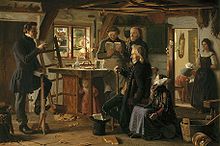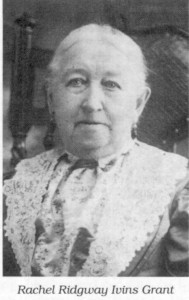27Nov
By Kent Larsen
In his Encyclopedic History of the Church of Jesus Christ of Latter-day Saints, Andrew Jenson gives a list of the mission presidents of the Eastern States Mission, which generally had its headquarters in New York City, as the following:
Read the rest of this entry »
Like this:
Like Loading...
Tags: Eastern States Mission, Immigration
Posted in Historical Notes | 4 Comments »
21Nov
By Kent Larsen
Last week I wrote about a November 1869 article from the New York Times that claimed that the LDS Church was about to build a “Temple” in New York City. But the building described was more like a hotel for immigrants with an integrated meetinghouse than a temple as we know it today. But the idea of even a Mormon immigration way station in the city deserves some consideration. Would such a structure have helped? Was it needed?
Read the rest of this entry »
Like this:
Like Loading...
Tags: Hotel, Immigration, New York Times, rail travel, sailing ships, steamships
Posted in Historical Notes | No Comments »
14Nov
By Kent Larsen
Perhaps the most audacious article about Mormons in New York City that I have discovered is an 1869 article in the New York Times that claimed that a Mormon Temple would soon be built in the city and that $500,000 had been set aside for its construction.
Only it wasn’t a temple the way Mormons today think of it.
Read the rest of this entry »
Like this:
Like Loading...
Tags: Building costs, Hotel, Immigration, maintenance costs, New York City, Temple
Posted in Historical Notes | No Comments »
06Nov
By Kent Larsen
The Christian Observer of September 10, 1841 included an unusual item, a 3,000 word article entitled “Journal of a Mormon” drawn on exactly that, the journal of convert William I. Appleby covering a trip he took to visit Nauvoo a year or so after his conversion. According to the Observer, Appleby had apparently planned to publish this as a pamphlet—but no pamphlet is now extant.
Read the rest of this entry »
Like this:
Like Loading...
Tags: 1841, Appleby's Journal, Burlington County New Jersey, Christian Observer, Church Archives, Nauvoo, Recklesstown, William I. Appleby
Posted in Historical Notes | 3 Comments »
29Oct
By Kent Larsen
 Given the state of medical knowledge during the 19th century, it seems likely that missionaries could have unwittingly spread disease, as they traveled from area to area. Historically, traveling merchants are today thought to have been a factor in spreading disease around the world, although I’m not sure to what extent that was known historically. It was considered a possibility early in Mormon history, if the following article is any indication. Local residents in Western New York State feared that Mormons might spread smallpox, and that Mormon beliefs might exacerbate the possibility:
Given the state of medical knowledge during the 19th century, it seems likely that missionaries could have unwittingly spread disease, as they traveled from area to area. Historically, traveling merchants are today thought to have been a factor in spreading disease around the world, although I’m not sure to what extent that was known historically. It was considered a possibility early in Mormon history, if the following article is any indication. Local residents in Western New York State feared that Mormons might spread smallpox, and that Mormon beliefs might exacerbate the possibility:
Read the rest of this entry »
Like this:
Like Loading...
Posted in Historical Notes | No Comments »
24Oct
By Kent Larsen
 For early Mormon church members in Nauvoo the death of Joseph Smith and the ensuing anti-mormon violence must have been very traumatic. With the trek westward beginning more than 18 months after the martyrdom and with initial uncertainty over who exactly should lead the Church, many members must have been uncertain what to do. And at least some of them decided to just go home.
For early Mormon church members in Nauvoo the death of Joseph Smith and the ensuing anti-mormon violence must have been very traumatic. With the trek westward beginning more than 18 months after the martyrdom and with initial uncertainty over who exactly should lead the Church, many members must have been uncertain what to do. And at least some of them decided to just go home.
Read the rest of this entry »
Like this:
Like Loading...
Tags: Hornerstown, Philip Curtis, Rachel R. Ivins, Return, Thomas A. Lyne
Posted in Historical Notes | No Comments »
17Oct
By Kent Larsen
In the mid to late 19th century, if you knew something unusual, of public interest, you set up a series of lectures on the issue, and toured starting in New York and Boston. Like it is today, this was a very common approach to the issues of the day, something less expensive and involved than publishing a book (in fact, it was a common way of promoting a book), and something that allowed discussion of issue more complex and involved than what could be published in newspapers. And Mormonism was one of those frequent topics that appeared on the lecture circuit.
Read the rest of this entry »
Like this:
Like Loading...
Tags: Artemus Ward, Books, Boston, Boylston Hall, Clinton Hall, George J. Adams, Hope Chapel, John C. Bennett, John Hyde, Josiah Quincy, Lectures, Mark Twain, National Hall, New York, Origen Bachelor, Thomas A. Lyne, William Smith
Posted in Historical Notes | No Comments »
11Oct
By Kent Larsen
 This past week I came across a couple of newspaper articles suggesting that Mormons were looking to rent or even acquire real estate in Philadelphia in the 1840s. Given that there were perhaps 300 Church members in Philadelphia at the time, the idea seems improbable. But, these claims made the newspapers at the time.
This past week I came across a couple of newspaper articles suggesting that Mormons were looking to rent or even acquire real estate in Philadelphia in the 1840s. Given that there were perhaps 300 Church members in Philadelphia at the time, the idea seems improbable. But, these claims made the newspapers at the time.
Read the rest of this entry »
Like this:
Like Loading...
Tags: Assembly Building, Benjamin Winchester, Chestnut Street Theatre, George J. Adams, Philadelphia, Real Estate, Thomas A. Lyne
Posted in Historical Notes | 6 Comments »
28Sep
By Kent Larsen
[I’m sorry that I’ve been negligent in posting this past two months. Vacation and what I might call “recovery from vacation” have thrown me off my schedule. I hope to return to posting weekly or close to it.]
If you think of American political tactics before 1850, images of political machines like Tammany Hall and violent disagreement quickly come to mind. Given that, we might expect that the conventions held in support of Joseph Smith’s candidacy for President of the United States might have at least occasionally attracted opposition from local machines, even if the attempt didn’t have much chance of success.
So I wasn’t surprised to find that the “Jeffersonian” convention held in Boston on July 1st, 1844 (news of Joseph Smith’s martyrdom hadn’t yet reached Boston) was labeled a “Mormon War” by the time news of the convention was reprinted in the New York Herald on July 4th. That report came from the Boston Times of July 2nd. The following extract gives an account of what happened:
Read the rest of this entry »
Like this:
Like Loading...
Posted in Historical Notes | No Comments »
25Jul
By Kent Larsen
When news of the martyrdom of Joseph Smith reached New York City and was published in the major New York newspapers on July 8th, Church members in the city were initially cautious about the news. Reports of Joseph Smith’s death or some other tragedy had appeared before and turned out to be incorrect.
The Latter Day Saint newspaper in New York, The Prophet, had already cautioned members on June 29th (probably because of the scandalous news reports similar to what was published in the Nauvoo Expositor, which were then reaching New York City) “not to credit the many tales afloat respecting our people, we have had no intelligence of trouble, and doubt very much the truth of these statements.”
But church members received confirmation of the martyrdom by July 20th, which left them wondering how to mourn for the fallen prophet.
Read the rest of this entry »
Like this:
Like Loading...
Tags: Brooklyn, crape, Martyrdom, New York branch, New York City, Philadelphia, Samuel Brannan, The Prophet, Token of Respect, wearing black, William Smith, Williamsburgh
Posted in Historical Notes | No Comments »


